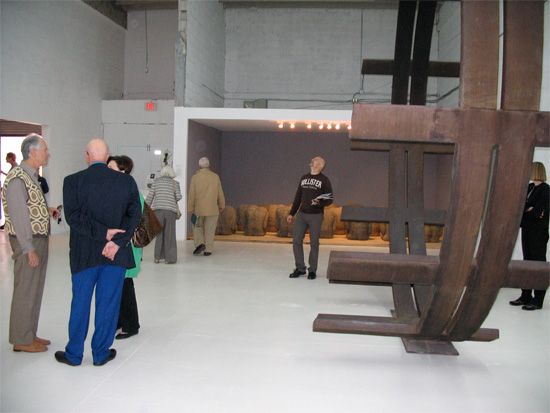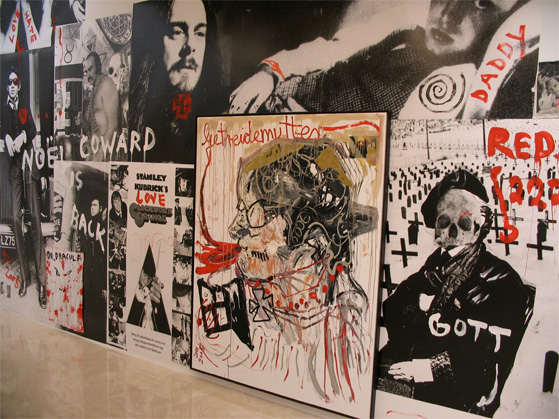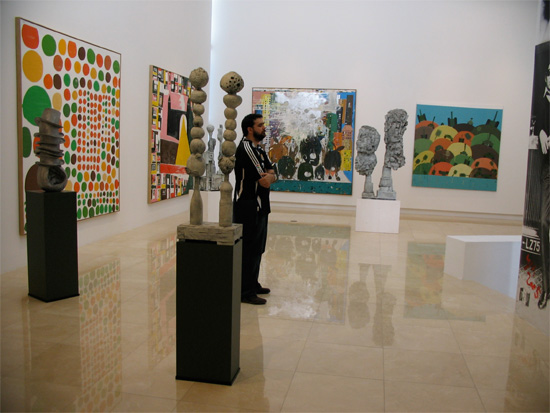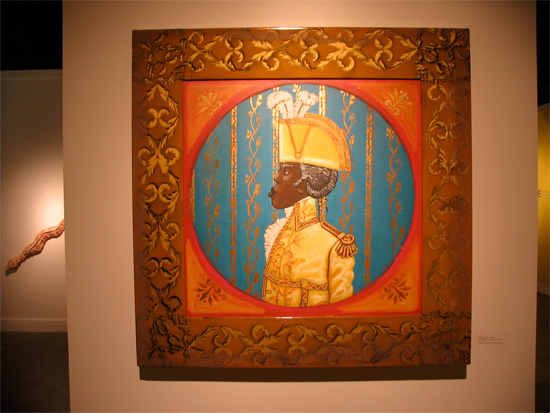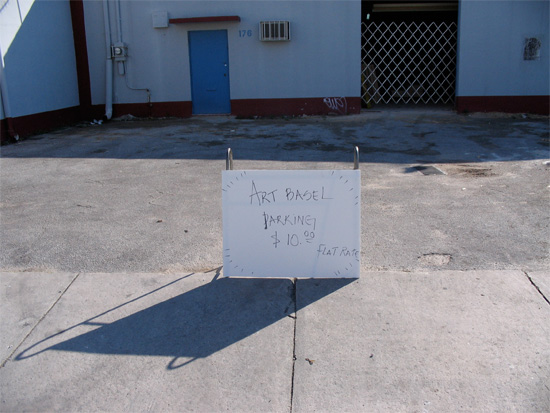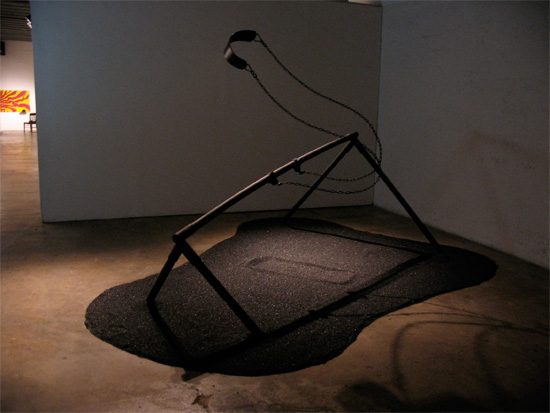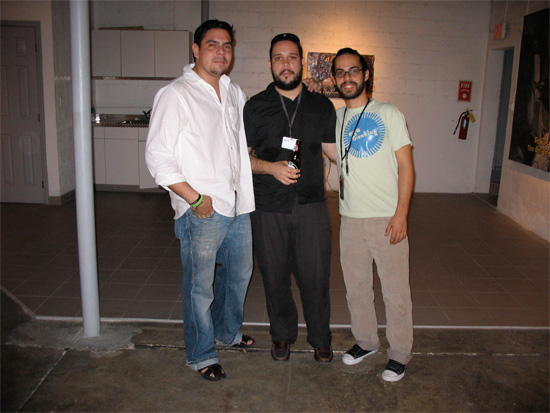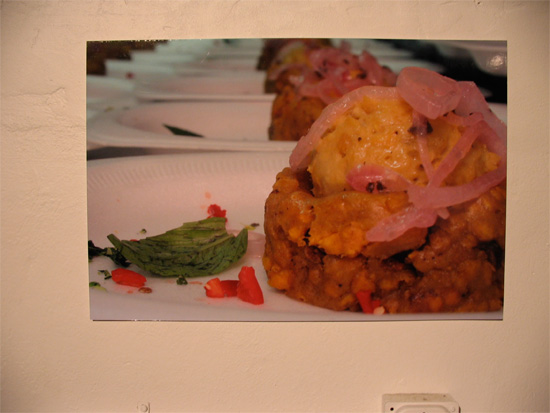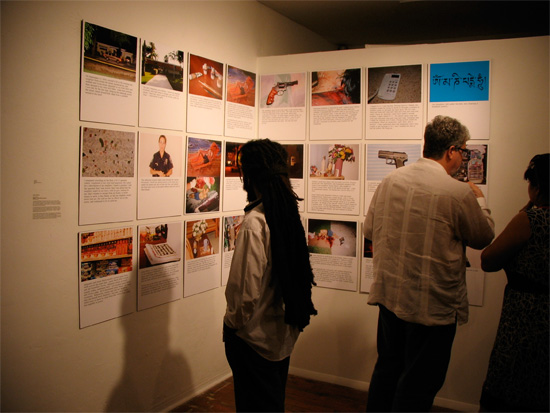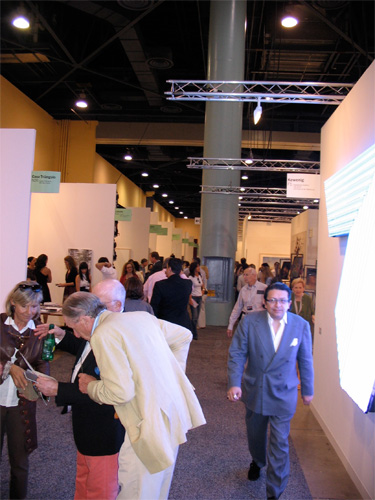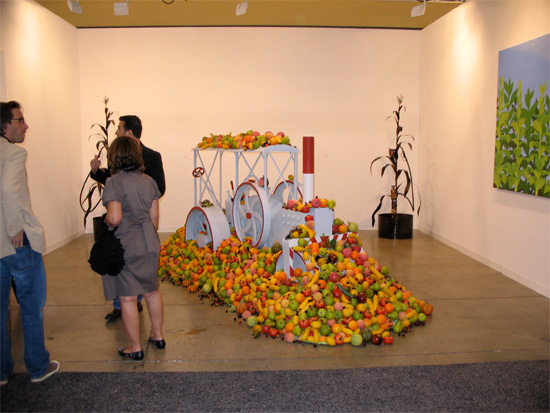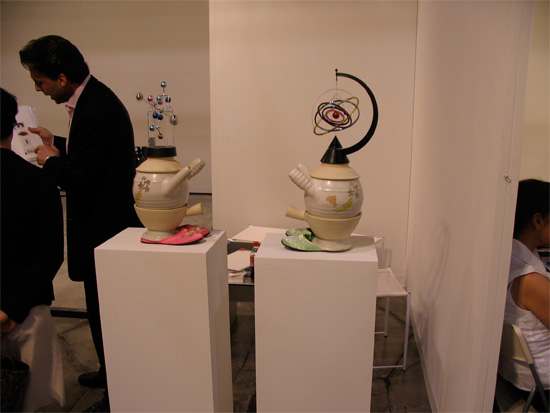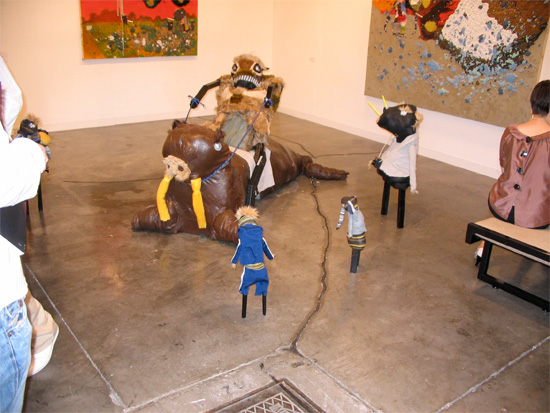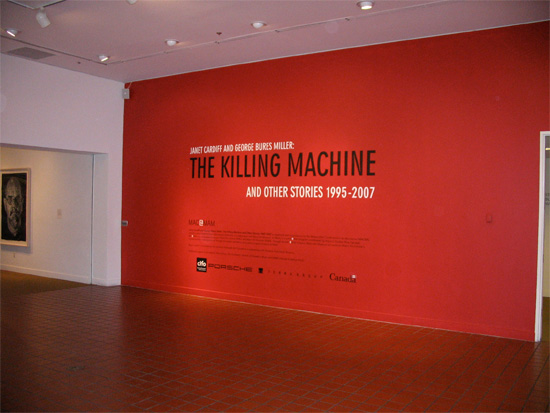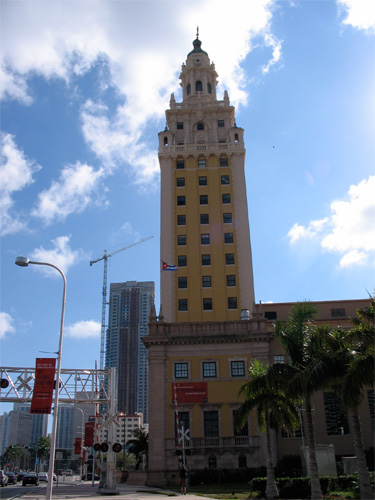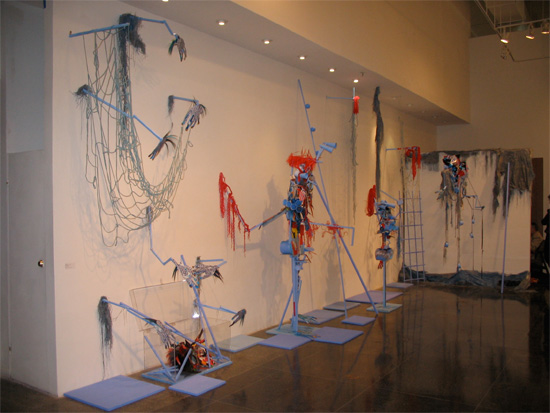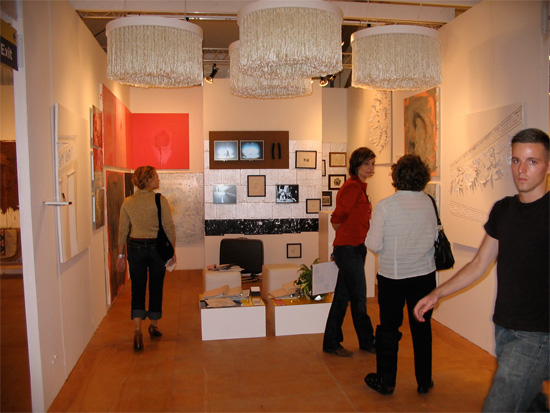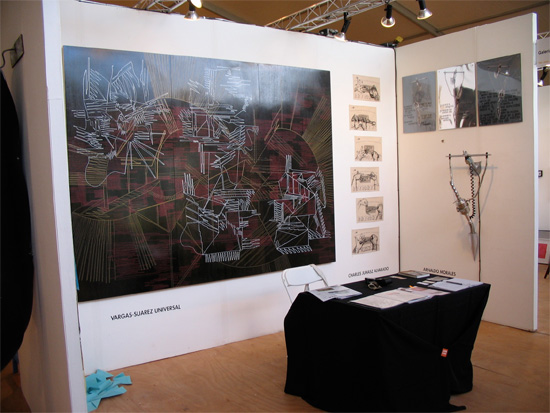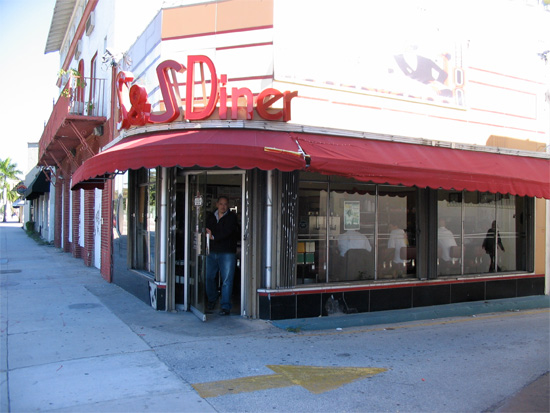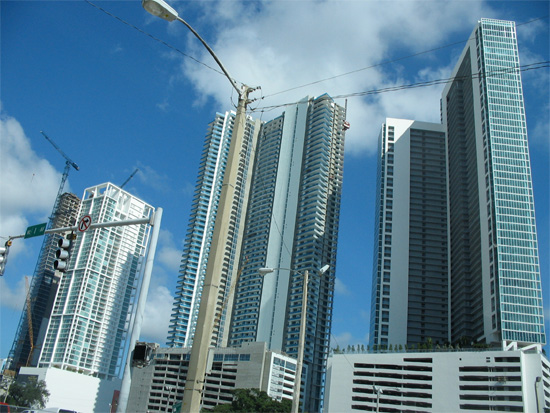
(more Simply Big)
The Margulies warehouse seems like nothing so much as the storage room of a compulsively acquisitive man who, fortunately, has decent taste in humungous sculpture. The last time we looked his warehouse was home to enough photographs and video works to boggle the most catholic mind, but only a handful remain on display these days.
At Rosa de la Cruz’s home, we were treated to works by two individuals we’d only recently learned of, Tal R and Jonathan Meese, who are David Schnell’s favorite ironic painters, the Leipzig artist himself assured us. Meaning that they treat painting ironically, not that they, like almost everyone on the planet, use irony in their paintings. We must admit that Jonathan Meese, as much as any new discovery during the fair, pretty much tickled our fancy. Lots of invented words and washed-up celebrities in his paintings, or celebrities in incredibly loopy roles. Sean Connery as Pancho Villa? Really. Meese is said to be beyond the beyond in his performances—chugging down the spirits, spritzing the floor—and you catch more than a glimmer of this in his works. Way to go, Rosa.
Little jewels it’s likely no one saw: our friend José Pérez organized an exhibition of Edouard Duval-Carrié paintings and sculptures at the gallery at the Bake House, a complex of artists’ studios in a kind of old-fashioned garment district not far from Wynwood. Not that you hadn’t seen the works before if you’d been paying attention, but it was all vintage Duval-Carrié: Toussaint L’Overture as satin-clad soldier-dandy, a shell-bedecked river goddess floating amidst lush fronds and palms, and other works seething with color, violence, and sumptuous degeneracy.
The rest: Art Positions, once known simply as The Containers, was largely a bore. As we stumbled about Wynwood in search of spiritual uplift, we came across this sign of the times. The business owner seemed to be getting his due, fine; but what did this mean for Brook Dorsch Gallery across the street? We’ll have to ask Brook, who was lolling about Scope at the time, trying to scare up some business. Speaking of heroic enterprises, his takes the cake. Dorsch has been around since before the steam train, we believe, twelve or fourteen years by now; has consistently shown work he believes in for no other reason than he believes in it; has a long list of devoted artists and artworld interested parties, if not a Swiss bank account; and raises money for worthy causes like nobody’s business. The gallery looked very good, a kind of potpurri of gallery regulars and obscure, strange new finds, with a marvelously black, black, black on black Ralph Provisero coal-dust and sunken swingset sculpture fronting it all.
The Puerto Rican factor: we were encouraged to see who made the trip; ambitious, smart young artists and some of the best-informed collectors and dealers on the island. Michele Fiedler brought a sampling of what is presently San Juan’s most worthwhile contemporary art program—Galería 356—to Photo Miami. She was showing a work by José Jorge Román, whom we caught in our peripheral vision as Paco Barragán yakked himself blue in the face, trying to convince us he is up to something that makes an iota of real sense. We espied Walter Otero and Melvin Martínez in the mob scene at the Moore Space opening, along with Celina Nogueras. Milly and Chilo Andreu stalked the halls of the fair with us for a short distance, Chilo dispensing his usual wisdom. John Belk and Margarita Serapión were about. We bumped into Luis Gutiérrez more than once, and there were Luis Agosto-Leduc and Mariely López in the fair’s confusing, cavern-like Supernova subdivision, trying to make the best of it.
When we ran into Abdiel Segarra and his companions, Rafael Miranda and Karlo Ibarra, upstairs at Edge Zones, they seemed energized; whether by the experience or a lack of sleep it was hard to tell. Hector Madera’s installation in Photo Miami would be a knockout anywhere, of course—it was the work Optical Borderline: Housing Development Project which Madera showed last year as a Lexus winner, viewable in all its pink neon glory via Repuesto here—and we hope it was widely seen. The crowds at Photo Miami looked good to us. One of the Puerto Rican contingent was disappointed at her slow to non-existent sales, but Nani Fernández had exactly the right spirit; exuding her sunniest indefatigability, she easily outshone the commerce swirling relentlessly around her. We’re almost certain this is the wave of Puerto Rico’s future.
What we missed and wished we hadn’t: as we’ve mentioned elsewhere, Museum of Contemporary Art’s Jorge Pardo exhibition was getting raves from everyone we talked to. Although we heard wildly mixed things about NADA, the scales seemed to tip towards the kinder views, but we never made it there. What can we say? José Bedia had a show of new work at Fred Snitzer Gallery, always worth a look. We’d have liked to spend more time at Scope and Pulse because they looked good to us, and Art Miami because we’re completely baffled about what it’s become after all these years. What’s the frequency, Kenneth? We had to rush in and out of Diaspora Vibe Gallery in the Design District, another great, purely Miami labor of love. Like Brook Dorsch, Rosie Gordon Wallace has also been at it for eons, promoting young local artists—and established international ones—with formidable energy and passion. What else? There were various panels, both within and without the fair—one involving critics, no thanks—but we didn’t hear a word. We caught only the last gasp of ABMB’s extensive video program; a lineup close to our hearts since it featured artists from the Pacific Northwest. But guess what? We feel fine about what we saw and what we didn’t. Less is best.
The fair: oh, was there an art fair going on? We’ve nearly lost our voices, so pictures must speak the thousand words we thought we had left. Before we fall relatively silent, we should mention that at Art Basel Miami Beach, it seemed that no collector was left behind. In addition to the above-mentioned friends, we passed a brief buen rato with César Reyes and Mima, our paths constantly crossed with that of Pepe Álvarez, and if one hung out near Eigen + Fine Art it was fairly impossible to avoid Alberto de la Cruz. Not that we wished to, of course. And just because we want to: a few perhaps hackneyed but still, to us, memorable views of Miami follow. Gratis. Please try out our somewhat ramshackle comments feature. In the Internet age, it’s so quick and easy to be, well, whomever you want.
|

